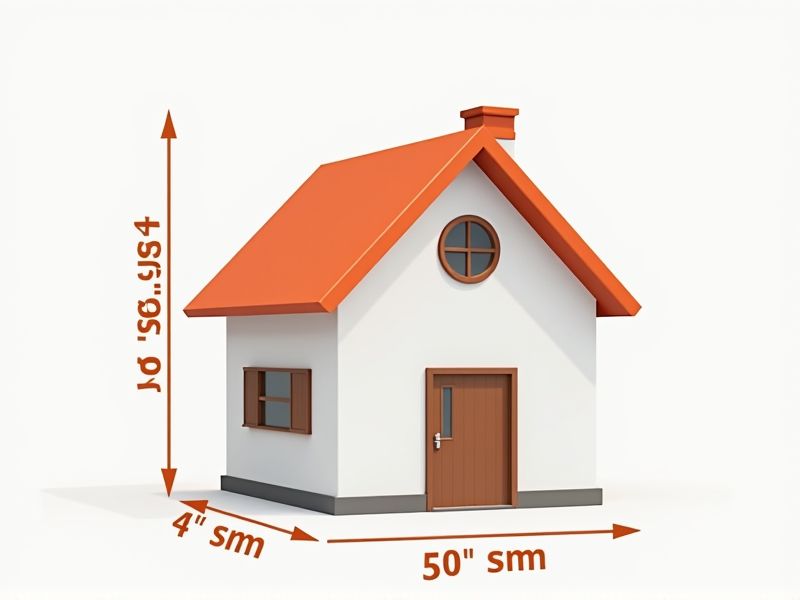
When planning a house, understanding standard dimensions helps ensure rooms are functional and comfortable. Typically, living rooms range from 12x18 feet to 16x20 feet, providing enough space for seating and movement. Bedrooms often start at 10x12 feet for smaller rooms, while master bedrooms can be 12x14 feet or larger. These standard measurements can be adjusted based on your family's needs and plot size, but using them as a baseline helps create an efficient and inviting home layout.
Square Footage
The standard of a house is often evaluated based on its square footage, with the average size of new single-family homes in the U.S. reaching approximately 2,500 square feet in 2023. Square footage impacts not only the overall value but also the livability and functionality of the space. Homes with expansive square footage typically provide more opportunities for versatile layouts, accommodating varying family dynamics. Consider your needs when selecting a home size, as a well-planned floor layout can enhance your living experience significantly.
Ceiling Height
The standard ceiling height for residential homes typically ranges from 8 to 10 feet, impacting both aesthetics and functionality. Higher ceilings, above 10 feet, can create a sense of spaciousness, improving airflow and natural light, making rooms feel more inviting. Lower ceilings, generally below 8 feet, may result in a cozier atmosphere but can also limit air circulation and light penetration. According to building codes, it's essential to meet these height specifications to ensure proper ventilation and safety in your living spaces.
Room Dimensions
A standard house typically features room dimensions that enhance functionality and comfort. For example, the average size of a living room ranges from 200 to 400 square feet, providing ample space for social gatherings. Bedrooms generally measure between 120 and 200 square feet, accommodating essential furniture like a bed and a nightstand. Kitchens usually offer around 150 to 250 square feet, allowing for efficient movement during meal preparation and cooking.
Door Width
The standard door width for residential homes is typically 36 inches, allowing for easier accessibility, particularly for individuals with mobility challenges. In some cases, smaller doors, measuring around 30 inches, are used in specific areas like bathrooms or closets, while larger entryways may feature widths up to 42 inches. It is crucial to consider these dimensions when planning your home layout, as wider doors can enhance the flow of space and improve functionality. Compliance with local building codes often mandates specific door widths to ensure safety and ease of movement throughout the home.
Window Size
The standard window size for residential houses often measures 36 inches by 48 inches, which provides a balance between natural light and energy efficiency. Your choice in window size can impact ventilation, with larger windows promoting airflow while smaller ones may be more suitable for energy conservation. Typically, energy-efficient windows can save homeowners up to 30% on heating and cooling costs annually. Incorporating larger window designs, such as floor-to-ceiling models, can enhance aesthetics while potentially increasing the property value by up to 10%.
Hallway Width
The standard hallway width for residential buildings typically ranges from 36 inches (91 cm) to 48 inches (122 cm) to ensure adequate space for movement and accessibility. Wider hallways, ideally 42 inches (107 cm) or more, enhance accessibility for individuals using mobility devices. Implementing a standard width not only improves your home's flow but also increases safety, allowing for easier emergency evacuations. Building codes in many regions may vary, so always check local regulations to ensure compliance with hallway width standards.
Staircase Dimensions
Staircase dimensions play a vital role in home safety and design, with the standard rise height set between 7 to 8 inches (18 to 20 cm) and a tread depth of at least 10 inches (25 cm). A typical staircase width should be at least 36 inches (91 cm) to allow for safe passage. Depending on the layout, an optimal pitch or slope is around 30 to 35 degrees for comfort and accessibility. When planning your staircase, consider local building codes, which often dictate specific requirements to ensure safety and usability.
Garage Size
When determining the standard for garage size, the ideal dimensions often start at 24 feet by 24 feet to comfortably accommodate two standard vehicles. A single-car garage typically measures 12 feet by 24 feet, providing sufficient space for vehicle entry and movement. If you own larger vehicles such as SUVs or trucks, consider a minimum width of 14 feet to ensure easy access. In addition to vehicle space, it's essential to factor in extra room for storage or work areas, which can enhance your garage's functionality and organization.
Lot Size
Lot size plays a crucial role in determining the overall value and functionality of a residential property. Typically measured in square feet or acres, a standard lot size ranges from 5,000 to 10,000 square feet for urban homes, while rural properties may span larger areas. A larger lot can offer added privacy, outdoor space, and potential for future expansion, making it a desirable feature for many buyers. When assessing a property's lot size, consider how it aligns with your lifestyle and future needs.
Wall Thickness
Wall thickness significantly impacts the structural integrity and energy efficiency of a house. Typically, exterior walls range from 4 to 12 inches in thickness, depending on materials like wood, brick, or concrete. A thicker wall may offer better insulation, reducing heating and cooling costs by up to 30%. When choosing a home, consider how wall thickness influences both comfort and long-term maintenance costs.
